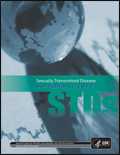GISP Profiles, 2010
This web page is archived for historical purposes and is no longer being updated. Newer data is available on the STD Data and Statistics page.

Figure A Data - Age of GISP Participants, 2010
Figure B Data - Race/Ethnicity of GISP Participants, 2010
Figure C Data - Percentage of GISP Participants Identifying as Men Who Have Sex with Men, 2000-2010
Figure D Data - Drugs Used to Treat Gonorrhea Among GISP Participants, 2010
Figure E Data - Drugs Used to Treat Chlamydia Trachomatis Infection Among GISP Participants, 2010
Figure F Data - Resistance to Penicillin, Tetracycline, and Ciprofloxacin Among GISP Isolates, 2010
Figure G Data – Distribution of Minimum Inhibitory Concentrations (MICs) to ceftriaxone among GISP isolates, 2005-2010
Figure H Data - Distribution of Minimum Inhibitory Concentrations (MICs) to cefixime among GISP isolates, 2005-2006 and 2010
Figure I Data - Intermediate Resistance and Resistance to Ciprofloxacin Among GISP Isolates, 1990-2010
Figure J Data - Distribution of Minimum Inhibitory Concentrations (MICs) to azithromycin among GISP isolates, 2005-2010
The Gonococcal Isolate Surveillance Project (GISP), a national sentinel surveillance system, was established in 1986 to monitor trends in antimicrobial susceptibilities of Neisseria gonorrhoeae strains in the United States among selected sexually transmitted diseases (STD) clinics in approximately 25-30 GISP sentinel sites.
Annual Reports were published for the years 1998–2007. Starting with 2008 data, site-specific GISP profiles have been published online each year. Aggregated GISP data are presented in the STD Surveillance, 2010 report.
The following site-specific profiles consist of figures depicting the demographic and clinical data of the men with gonorrhea enrolled in GISP and the antimicrobial susceptibility results of the Neisseria gonorrhoeae isolates submitted.
Explanation of Site-Specific Demographic, Clinical, and Laboratory Data
Print all 2010 profiles [PDF - 14 MB]
All Years GISP Profiles and Annual Reports
- Page last reviewed: March 19, 2012 (archived document)
- Content source:


 ShareCompartir
ShareCompartir